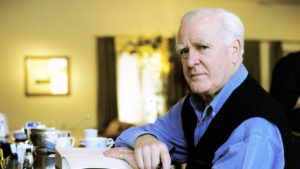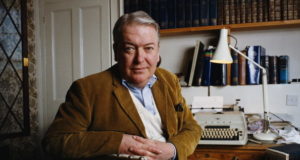Think Milton Keynes, with touches of Harlow, Stevenage or Crawley. Its location in relation to the capital, though, plants the town closer to Watford, even Slough. You might just about imagine a winner of the Nobel Prize in Literature growing up in a place like that. Still, for a laureate to choose such an address and then stay there willingly for almost half a century would bemuse, if not appal, the smarter sort of literary mind.
Yet Annie Ernaux, who last Thursday became the first Frenchwoman to take the literature Nobel, moved to the new town of Cergy-Pontoise — 30 kilometres north-west of central Paris — in 1975. She has remained there, in her house on a bend in the Oise, ever since. She writes all her works in Cergy: a long-settled outsider among other incomers, “in the midst of lives started elsewhere” (as she reflects in her journal Exteriors) “in Vietnam, the Maghreb, Côte d’Ivoire, the French provinces or, as was mine, in Normandy”.
After the Swedish Academy announced its choice for 2022, the reporter from Le Figaro hurried up to Cergy, put in some sterling legwork, and found the retired neighbour who looks after the author’s cat. She who told him that Ernaux stood for “Auchan” (read Tesco, maybe Asda), “the provinces, the ordinary, women”. Over in Cergy’s monumental civic centre, the Axe Majeur, the kids hanging around in the sun hadn’t heard of their illustrious fellow-citizen. But they soon began pounding their mobiles to find out about her. “At last, people are going to say something good about Cergy,” one hoped.
There’s much that’s good — or at any rate rich, complicated and interesting — to be said about Cergy-Pontoise and the other planned communities that spread across Europe in the decades after the Second World War. For the most part, however, mainstream literature, film and even journalism is not where you will find it. For sure, Ernaux — born in Normandy in 1940 to peasant-born parents who became the proprietors of a small-town café-grocery — writes in pared-down, pin-sharp prose about intimate experiences shared across classes, cultures and continents.
Since the late Seventies, her creative memoirs have pierced the veils of shame, silence and taboo to dramatise the most intimate wounds: her father’s class-bound rage (in A Man’s Place), her mother’s thwarted life and descent into Alzheimer’s (A Woman’s Story), a convulsive affair (Simple Passion), a bruising sexual initiation (A Girl’s Story), an illegal abortion (Happening). She gave shape, grace, even beauty, to the mucky froth of memory. Then, in her 2008 book The Years, she turned the stray junk of consumer culture that accumulates in everybody’s brain into material for a masterly collective autobiography of France from the war’s end to the millennium. It was like building a literary Chartres Cathedral out of ring-pulls, bottle-tops, milk cartons and fag packets.
Read some recent Anglophone tributes to Ernaux, however, and you might think that she writes the brand of abstract, disembodied auto-fiction that floats mistily above everyday existence until it comes to rest in its spiritual home: the university seminar-room. Au contraire. Just as she roots her writing in the frail, fleshly, vulnerable (female) body, so she grounds it in specific, closely-observed places. She tells stories about the events or feelings that give rise to scorn, embarrassment, even disgust. And she sets them in spaces that polite voices will (still) patronise as tacky, vulgar and soulless.
“Come friendly bombs and fall on Slough!” cursed John Betjeman — the bard of an older, more sedate variety of suburbia — in 1937 about a boom-town that prefigured many later developments. A dozen stops up the RER line from Charles de Gaulle-Etoile, Cergy has never quite attracted Slough levels of disdain. But Ernaux’s stubborn loyalty to it reveals much about her career as an author and the fault-lines that still splinter culture in France, Britain, or elsewhere in the West. Yes, we’re talking class — though not in the way that an older generation of socially-committed writers would have conceived it.
Ernaux does not eulogise a mythological proletariat, or a persecuted underclass in the tower-block banlieue, from a safe perch in a Left Bank café or a fine converted mas on some Provençal hillside. Rather, she lives in and writes from the kind of mixed community where people come to make, or remake themselves, amid the shopping centres, the flagstoned plazas, the geometric parks and boxy housing estates of the exurban dream. At first, this new-minted townscape disoriented her, as, in the Seventies, it rapidly sprang from blueprint to building-site. She felt marooned among “the windswept esplanades, the concrete façades, pink or blue, and the empty residential avenues”. Then the people came; the supermarkets opened; the commuter trains to Paris filled. In and around Cergy she found the right stage on which to mount her exploration of “the violence and shame inherent in society”, and her quest to discover the human essence of “anything that appears to be unimportant or meaningless simply because it is familiar or ordinary”.
Cergy, like four other new towns ringed around Paris, came into being in the wake of the SDAURP (Schema d’Amenagement et d’Urbanisme de la Region Parisienne) plan of 1965: almost 20 years later than Britain’s first wave of New Towns, but roughly at the same time as Milton Keynes. In 2022, it marks 50 years of official existence after Paris master-planner Paul Delouvrier saw his cherished villes nouvelles begin to rise. They offered an alternative — more socially diverse, integrated and architecturally ambitious — to the housing projects of the banlieue that had fast descended into sink estates. Places like Cergy (in France or Britain) can boast neither a chic pedigree — though Pissarro and Cézanne painted on the still-wooded banks of the Oise — nor the pathos and heroism of deprivation. Taste-makers tend to treat them with sheer indifference, lofty pity, or mocking condescension. So Ernaux’s insistence that we find a key to unlock the secrets of modern social and emotional lives in the new-town grocery queue, the hairdresser’s salon, or the crowded Tube carriage, counts as a quietly revolutionary act. For her, “a supermarket can provide just as much meaning and truth as a concert hall”.
Britain’s new towns and cities still await their Ernaux. True, we have Mike Leigh-style social comedy aplenty: aspiration, embarrassment and humiliation in off-the-peg executive homes or kitsch bistros. You can argue until the (concrete) cows come home about whether this mode grows from a place of love or hate. But, even at its best, it soon runs into strict limits of tone and scope. Elsewhere, the strong British tradition of satirical urbanism — tart and witty in an architectural writer like Ian Nairn, florid and visionary in the exurban rambles of Iain Sinclair — does not exactly condescend to dwellers in new towns or in the residential sprawl that Nairn dubbed “subtopia”.
It inclines to treat them as victims, specimens or casualties. Worse, new towns became dystopian backdrops for tales of social anomie and breakdown: Stanley Kubrick filmed some of A Clockwork Orange on the brutalist Southmere Estate in Thamesmead. JG Ballard (in fiction) and Jean Baudrillard (in critical theory) have much to answer for in this prefab notion of the planned urban ensemble as an inevitable hell-hole of alienation. Invest properly in amenities and services, and the metaphysical anguish supposedly bred by new-town architecture mysteriously dissolves. True, Cergy for Ernaux — even in its more stylish, affluent corners — may figure as a microcosm of consumer capitalism, with all its anxieties and insecurities. But she never pretends that you’d escape it by moving to Menton or Montparnasse.
In Ernaux’s work, we make the memories that matter out of anywhere and anything. And I should confess that my fondness for her work has a little to do with another, richly recollected, version of the suburban scene. Much of her 2016 book A Girl’s Story recounts, with her trademark candour, clarity and insight, a teenage sexual encounter at a summer camp in Normandy. Its final act, however, moves on to the young Annie’s stint in 1960 as an au pair in North Finchley, London N12. We lived a few hundred yards away from the shops at Tally Ho Corner where the young French help gleefully guzzles “lemon curds, shortbreads, trifles, Smarties and Milky Ways, bars of Caramac and Dairy Milk”. A couple of years later, I would have bought the same sweets at the same counters she evokes in some positively rhapsodic passages. Take that, Monsieur Proust with your tisane-dunked madeleine (Ernaux certainly knows, and loves, her A la recherche du temps perdu).
When, in 1989, she took a nostalgic trip up the Northern Line to revisit North Finchley, even the Gaumont cinema (where I spent many Saturday mornings) had gone and “only the Woolworth’s remained”. Alas, not for much longer. In London, as in Normandy, Annie suffers the traumas and terrors of adolescence. They unfold, though, in the midst of all the mundane actualities that anchor our memories in both place and time. One late-summer Sunday in 1960, she sits “alone on a bench in a park near Woodside Park Station. Children are playing. I have brought things to write with. I start a novel…” Thus the six decades of a Nobel laureate’s literary career launch from a park bench (almost) at the outer-suburban end of a Tube line. Ernaux still lives, and writes, from the end of the line. There are worse places to start from.
Disclaimer
Some of the posts we share are controversial and we do not necessarily agree with them in the whole extend. Sometimes we agree with the content or part of it but we do not agree with the narration or language. Nevertheless we find them somehow interesting, valuable and/or informative or we share them, because we strongly believe in freedom of speech, free press and journalism. We strongly encourage you to have a critical approach to all the content, do your own research and analysis to build your own opinion.
We would be glad to have your feedback.
Source: UnHerd Read the original article here: https://unherd.com/




